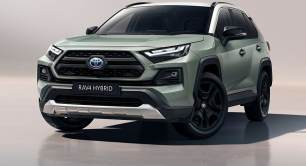Given the car's Australian launch is still some way off it's no surprise local pricing and specification is yet to be confirmed. But we can make some assumptions based on available trim levels and projected production scheduling.
The E-3008 is offered globally in entry-level Allure and top-spec GT grades with a choice of three powertrains - single-motor standard range, single-motor long range and dual-motor all-wheel drive.
That said, the single-motor standard range set-up will be the only configuration available until production of long-range and dual-motor versions begins in 2025.
So, initially we can expect the E-3008 Allure to include the latest version of Peugeot's 'i-Cockpit' dash layout and multimedia system featuring a single-piece, curved and swipe-able 21-inch panoramic screen combining media, instrumentation and vehicle control displays (as well as 'OK Peugeot' voice recognition). It's optional on the Allure in France but a safe bet as standard here.
Then you can add auto LED headlights, cloth and synthetic leather trim, keyless entry and start, an HD reversing camera (with rear parking sensors), six-speaker audio (with digital radio), dual-zone climate control, 19-inch alloys and the 'i -Connect' system, including wireless Android Auto and Apple CarPlay.
Step up to the GT and you're rolling on 20-inch rims, while you also pick up two-tone paint, pixel LED headlights, front parking sensors, an auto tailgate, Alcantara trim (genuine leather is an option in France), customisable ambient interior lighting, Focal 10-speaker premium audio (with 12-channel 690W amp), heated front seats and steering wheel, a head-up display and an induction smartphone charger. Also likely is the 'VisioPark 360' system (incorporating four cameras and 12 sensors).
As mentioned, Australian range and pricing are yet to be finalised but in the notoriously pricy UK market cost-of-entry for the E-3008 Allure is around £46,000 ($89,000 on a straight currency swap) with a roughly €45,000 ($75,000) starting price in France.
To be competitive locally we'd argue the E-3008 Allure will need to be under $70,000, putting it in the same ballpark as the Hyundai Ioniq 5 (2WD 125kW - $65,000) and Ioniq 6 (2WD 111kW - $65,500), Kia Niro EV (S Electric FWD - $66,590), Renault Megane E-Tech ($64,990), Tesla Model Y (RWD Single Motor - $65,400) and Volvo EX30 (Single Motor Extended Ultra - $64,990).
Worth noting that Hybrid and Plug-In Hybrid versions of the new 3008 will follow this pure EV, with timing and local availability yet to be confirmed.

